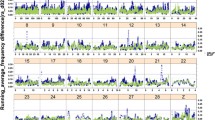Summary
Replicated within full-sib family single-trait selection was conducted for 10 generations in mice for (1) high or low 12-week epididymal fat pad percentage (100 x epididymal fat pad weight/body weight) or (2) high or low 12-week hind carcass percentage (100 x hind carcass weight/body weight). Pooled realized heritabilities based on high, low and divergent selection were 0.66±0.09, 0.65±0.13 and 0.66±0.05 for epididymal fat pad percentage and 0.48±0.08, 0.33±0.08 and 0.40±0.04 for hind carcass percentage. The pooled realized genetic correlation (rG R) between epididymal fat pad percentage and hind carcass percentage based on divergence was −0.67±0.04. Other estimates of (rG R) were: epididymal fat pad percentage with body weight (0.57±0.05); epididymal fat pad percentage with epididymal fat pad weight (1.17±0.05); hind carcass percentage with body weight (−0.61±0.09); hind carcass percentage with hind carcass weight (−0.05±0.11). Indirect measures of fat and lean tissue percentages were highly heritable, and (rG R) between them would be desirable from the standpoint of analogous types of traits in livestock. In the same context, undesirable (rG R)'s were found between epididymal fat pad percentage and body weight and between hind carcass percentage and body weight.
Similar content being viewed by others
References
Bhuvanakumar CK, Lynch CB, Roberts RC, Hill WG (1985) Heterosis among lines of mice selected for body weight. 1. Growth. Theor Appl Genet 71:44–51
Bohren BB, Hill WG, Robertson A (1966) Some observations on asymmetrical correlated responses. Genet Res 7:44–57
Cahaner A, Krinsky M (1985) The response to one cycle of divergent selection for abdominal fat in broilers raised under different conditions. Poult Sci 64:1813–1820
Eisen EJ (1966) Effect of the biometrical relationship among total milk yield, milk constituent yield and percent of milk constituent on response to selection. J Dairy Sci 49:1230–1234
Eisen EJ (1975) Population size and selection intensity effects on long-term selection response in mice. Genetics 79:305–323
Eisen EJ (1986) Selection for components of body composition in mice. 3rd World Congress Genet Appl Livestock Prod 11:389–394
Eisen EJ (1988) Selection for components related to body composition in mice: correlated responses. Theor Appl Genet (in press)
Eisen EJ, Leatherwood JM (1978) Adipose cellularity and body composition in polygenic obese mice as influenced by pre-weaning nutrition. J Nutr 108:1652–1662
Eisen EJ, Leatherwood JM (1981) Predicting percent fat in mice. Growth 45:100–107
Eisen EJ, Prasetyo H (1988) Estimates of genetic parameters and predicted selection responses for growth, fat and lean traits in mice. J Anim Sci (submitted)
Eisen EJ, Bakker H, Nagai J (1977) Body composition and energetic efficiency in two lines of mice selected for rapid growth rate and their F1 crosses. Theor Appl Genet 49:21–34
Falconer DS (1973) Replicated selection for body weight in mice. Genet Res 22:291–321
Falconer DS (1981) Introduction to quantitative genetics, 2nd edn. Longman, London
Hetzer HO, Harvey WR (1967) Selection for high and low fatness in swine. J Anim Sci 26:1244–1251
Hill WG (1971) Design and efficiency of selection experiments for estimating genetic parameters. Biometrics 27:293–311
Hill WG (1972a) Estimation of realised heritabilities from selection experiments: I. Divergent selection. Biometrics 29:747–765
Hill WG (1972b) Estimation of realised heritabilities from selection experiments. II. Selection in one direction. Biometrics 28:767–780
Horst P, Steinhart D, Weniger JH, Tawfik ES, Major F (1979) Preliminary selection results for the combination of total protein deposition and endurance in mice. Z Tierz Züchtungsbiol 96:221–234
Hörstgen G (1978) Modellversuch mit Mäusen zur genetischen Differenzierung von Zuchtlinien durch Selektion für quantitative Merkmale. Ph D Diss University of Göttigen (FRG)
Lang BJ, Legates JE (1969) Rate, composition and efficiency of growth in mice selected for large and small body weight. Theor Appl Genet 39:306–314
Leclercq B, Blum JC, Boyer JP (1980) Selecting broilers for low or high abdominal fat: initial observations. Br Poult Sci 21:107–113
Legates JE (1969) Direct and correlated responses to selection in mice. In: Bogart R (ed) Genetics lectures, vol 1. Oregon State University Press, Corvallis, pp 149–166
Lilburn MS, Leach RM Jr, Bass EG, Martin RJ (1982) The developmental characteristics of two strains of chickens selected for differences in mature abdominal fat pad size. Growth 46:171–181
Notter DR, Dickerson GE, Deshazar JA (1976) Selection for rate and efficiency of lean gain in the rat. Genetics 84:125–144
Osborne R (1957) Correction for regression on a secondary trait as a method of increasing the efficiency of selective breeding. Aust J Biol Sci 10:365–366
Richardson RH, Kojima K, Lucas HL (1968) An analysis of short-term selection experiments. Heredity 23:493–506
Rutledge JJ, Eisen EJ, Legates JE (1973) An experimental evaluation of genetic correlation. Genetics 75:709–726
Sharp GL, Hill WG, Robertson A (1984) Effects of selection on growth, body composition and food intake in mice. I. Responses in selected traits. Genet Res 43:75–92
Sutherland TM (1965) The correlation between feed efficiency and rate of gain, a ratio and its denominator. Biometrics 21:739–749
Wang CT, Dickerson GE (1984) Selection for rate and for efficiency of lean growth in rats: responses to selection and relaxation of selection. J Anim Sci 58:831–845
Webb AJ (1986) Genetic control of growth, composition, appetite and feed utilisation: non-ruminants. 3rd World Congress Genet Appl Livestock Prod 11:337–344
Whitehead CC, Griffin HD (1985) Direct and correlated response to selection for decreased body fat in broilers. In: Hill WG, Manson JM, Hewitt D (eds) Poultry genetics and breeding. Longman, Harlow, pp 113–123
Author information
Authors and Affiliations
Additional information
Communicated by G. Wenzel
Paper No. 10957 of the Journal Series of the North Carolina Agricultural Research Service, Raleigh, North Carolina 27695-7601, USA. The use of trade names in this publication does not imply endorsement by the North Carolina Agricultural Research Service of the products named, nor criticism of similar ones not mentioned
Rights and permissions
About this article
Cite this article
Eisen, E.J. Selection for components related to body composition in mice: direct responses. Theoret. Appl. Genetics 74, 793–801 (1987). https://doi.org/10.1007/BF00247559
Received:
Accepted:
Issue Date:
DOI: https://doi.org/10.1007/BF00247559




